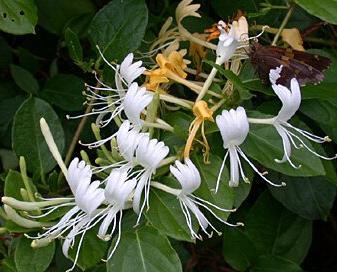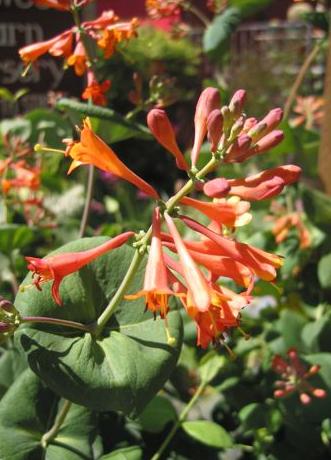Categories
Calendars
Guides
Reviews
Archive
Gallery
Articles
Ask Our Gardening Expert
Honeysuckle
The sweet scented, tubular summer flowers of this climber are followed in autumn by red or blue coloured berried. The flowers are attractive to insects and the fruit to garden birds.
Japanese Honeysuckle
The common, European honeysuckle or woodbine (Loneicera periclymenum) reaches to 6m, with creamy-white and purplish, 4-5 cm flowers. The Japanese honeysuckle (Lonicera japonica), is a rampant species, growing up to 9m, with semi-deciduous foliage and 2.5-4 cm, white to yellow flowers. It should be planted with care and can become an invasive weed if not controlled. The variety, ‘Aureo-reticulata’, with net veined leaves, is less vigorous. The most distinctive species is the giant Burmese honeysuckle (Lonicera hildebrandtiana) is more frost tender but hardy when established, produces 16cm long flowers and in a warm position, reach 12 m.
Giant Burmese Honeysuckle
Honeysuckle Care
Honeysuckle varieties are hardy, tolerating temperatures down to -15oC, is easy to grow dan with no special soil requirements other than it be cool and moist. Place new plants in full sun or semi shade 30 cm from trellis support and prune out old wood in winter. Use an all round fertiliser in spring to give some encouragement and mulch in summer. Some may be liable to aphid infestation, so treat with care as required and consider non-target insects and birds.
Propagation
Take nodal cuttings from new growth in spring or sow seed directly in the ground in spring or autumn.
HONEYSUCKLE AT A GLANCE
Honeysuckle (Lonicera) is a member of a genus of very hardy, evergreen and deciduous shrubs and climbers that originate widely across the northern hemisphere. 

Latin name
Lonicera
Type
Hardy deciduous and semi deciduous climber
Growing Conditions
No special soil requirements, sun or partial shade close to support.
Propagation